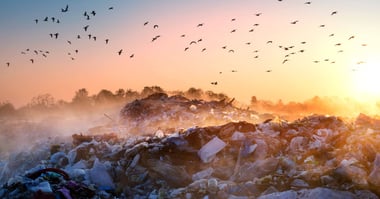Around 500 million tons of plastic waste is produced every year, according to Our World in Data — and mismanagement is one of the main reasons this overwhelming amount of plastic pollutes our oceans.
Of course, the effects of plastic use can’t be undone overnight, so the world has deployed a new type of thinking — the circular economy.
In terms of ocean-bound plastic (OBP), this means recovering plastic waste located near coasts or waterways that is at risk of entering the ocean, and injecting it back into the production of our favorite products and necessities.
Here, we look at the ins and outs of ocean-bound plastic, including what it is, its negative environmental impact, and the drive to incorporate it into our consumer goods.
What’s on this page?
01 | What is ocean-bound plastic (OBP)?02 | Types of ocean-bound plastic
03 | What are the grades of ocean-bound plastic?
04 | How does plastic get to the ocean?
05 | How does ocean-bound plastic impact the environment?
06 | What are the solutions to ocean-bound plastic?
07 | Summary
What is ocean-bound plastic (OBP)?
As the name suggests, ocean-bound plastic is plastic that could potentially end up in our oceans — this generates roughly 80% of plastic marine litter, according to the Ocean Bound Plastic Certification.
Although a very straightforward term, ocean-bound plastic stretches beyond littering on beaches. In fact, it’s often a result of mismanaged plastic waste inland.
While many might believe we can just recycle more to solve the problem, the reality is that a large percentage of marine litter actually comes from non-commercially recyclable plastic materials. Greenpeace paints a clear picture of this, reporting that only 5%–6% of plastics were actually recycled in 2022.
💡 Further reading: How much plastic actually gets recycled.
Types of ocean-bound plastic
Ocean-bound plastic is a few different types that are useful to be aware of:
- Potential OBP: This includes plastic waste that’s recovered from the environment located within 50 kilometers (km) of coastlines. According to Our World in Data, just shy of 21 million tons of plastic is leaked into the environment, while 6 million is lays among riversides and coastlines, which brings us to the next type of plastic waste...
- Waterway OBP: This includes plastic waste that’s disposed of into — or within 200 meters of — rivers that will eventually lead to the ocean.
- Shoreline OBP: This refers to mismanaged plastic waste recovered within 200 meters of the shoreline. This has a direct impact on the ocean as it can easily be swept in by tides, winds, or storm surges.
- Fishing material: You know the stuff, plastic used in fishing nets, cages, and other equipment to carry out commercial fishing operations. Our World in Data states that roughly a third of all plastic debris in our oceans is discarded by the fishing industry
What are the grades of ocean-bound plastic?
To understand the types of ocean-bound plastic, we also need to look at the different grades of plastic to see how it gets from our households to the ocean.
The ‘grading’ system is used to categorize certain sizes of plastic debris. Any materials visible to the naked eye are known as macroplastics, while others are much smaller — if not microscopic.
The majority of macroplastics that end up in the ocean are a result of areas that lack waste management infrastructure, and have no choice other than dump their waste, often in or near waterways.
However, all homes — wherever they are located — contribute indirectly to microplastic waste. The problem was first discovered over a decade ago, and the National Institute of Health (NIH) has since found that textile washing contributed to 35% of all microplastic ocean pollution.
While homeowners play their part in recycling waste correctly, this invisible hazard still exists, which causes havoc in the environment and in our food systems — impacting the health of sea life, animals near the coast, and the human population.
Here are the different categories of plastic grades, according to the NIH:
- Microplastics: Plastic particles that measure less than 2 mm in diameter, and are considered the smallest particles that are relatively non-visible in most circumstances
- Mesoplastics: Plastic particles from 2-20 mm in diameter
- Macroplastics: Marine litter that measures greater than 20 mm in diameter
How does plastic get to the ocean?
There are a number of ways the plastic waste (micro or macro) finds its way into the ocean, no matter the distance from the coastline. Ocean-based plastic is commonly traced through rivers and other waterways, as a result of littering or rubbish being dumped where there is no waste collection.
However, extreme winds whip up plastic debris from landfill sites and unexpectedly transport them to the coast. Also, litter from urban areas makes its way into drainage systems and is carried in water that eventually deposits in the sea.
According to The World Wildlife Fund (WWF), wind carries macroplastics towards streams and rivers, while rainwater allows another route through drainage systems.
Microplastics and microfibres can also make their way into greywater systems, which are ultimately consumed by sea life.
How does ocean plastic impact the environment?
Visual pollution, poor health, soil toxicity, and death of wildlife — these are the main ways ocean plastic pollution impacts the environment.
Litter is a burden on everyone, from the communities who live by the coast, to the animals that live in habitats where plastic pollutes. Failure to manage this leads to further issues, such as the breakdown of plastics and contamination of soil and water, which ultimately impacts the health of all life.
The Ocean Blue Project cites the impacts of chemicals in plastics on our health, which are linked to a decline in cardiovascular health and reproductive success. You can find out more about this on our page: How Does Plastic Affect Human Health?
The food that we consume — plants, fish, or mammals — is increasingly containing plastic, as the particles are so small and difficult to see and easy to ingest. However, the impact on sea life can be much more imminent as commercial fishing debris is known to impact turtles, coastal bird species, and other organisms.
Microplastics are detrimental to marine animals, causing 100 million deaths each year — in marine mammals, this is 100,000 every year.
One of the most protected animals of the ocean, the sperm whale, can die from ingesting a mere 30 kilograms of plastic (the equivalent of up to 150 plastic bottles), which causes inflammation of its abdominal tissue. Fishing nets, plastic shopping bags, and jerry cans are the key culprits.
In land mammals, the common cause of death is injury or strangulation from fish nets, ropes, and other flexible materials.
What are the solutions to ocean plastic?
While the tides are seemingly against us, as plastic is still a major problem globally, there are ways that businesses and governments can drive positive changes.
We already see an increase in initiatives, as companies understand their role in reducing waste nationally, and across borders. From reduction to innovation, here are the key actions to take to eliminate ocean-based plastic.
Implement better waste management systems
Mismanagement is a major concern for all countries, particularly low-income nations that battle the cost of waste management.
Often these countries are forced to incinerate plastic among many other types of waste. The alternative is littering in the open environment.
Take Sub-Saharan Africa as an example. The United Nations (UN) estimates the region poorly processes 90% of its plastic waste. The WWF says this is a result of extremely high costs — often 10 times higher in low-income countries.
Recover plastic in high-risk areas
More attention should be given to waste recovery in high-risk areas, such as coastlines, waterways, and areas that lack effective (or any!) waste management systems.
The impact of ocean plastic has on the health of the ocean solidifies the need to reduce the use of new plastics in production and reuse plastic that is already in circulation.
We're working with partners all over the world to prevent plastic from being dumped in the first place, and investing in waste management infrastructure where its needed most.

.webp)
-3.png)
.webp?width=380&name=Colourful%20corals%20(1).webp)

.webp?width=380&name=Plastic-pollution-surface-of-water%20(1).webp)

.webp?width=380&name=solar-collection%20(1).webp)
%20(1).webp?width=380&name=Pile-of-plastic%20(1)%20(1).webp)

%20(1).webp?width=380&name=Plastic-on-the-beach%20(2)%20(1).webp)
.webp?width=380&name=Plastic-bales%20(1).webp)

